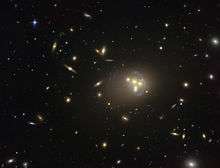ESO 146-5
ESO 146-5 (ESO 146-IG 005) is the designation given to a giant interacting elliptical galaxy in the center of the Abell 3827 cluster. It is well noted due to its strong gravitational lensing effect, measurements of which show the galaxy to be one of the most massive in the known universe, IC 1101 still being an estimated 3 times as massive.
| ESO 146-5 | |
|---|---|
 ESO 146-5 as seen by HST. The extended blue structures surrounding the central galaxies are gravitationally lensed views of a much more distant galaxy behind the cluster. | |
| Observation data (J2000 epoch) | |
| Constellation | Indus |
| Right ascension | 22h 01m 53.306s[1] |
| Declination | −59° 56′ 43.373″[1] |
| Redshift | 0.10083[1] |
| Distance | 1.4 Gly |
| Characteristics | |
| Type | E[1] |
| Other designations | |
| APMBGC 146+076+007, ENACS ACO 3827 11, 2MASX J22015330-5956437[1] | |
Physical characteristics
This interacting galaxy was found 1.4 billion light years away in the center of Abell 3827. A huge halo of stars is surrounding its interacting nuclei. It has immense gravity that holds the cluster together due to its mass. Its unusual shape has led to the conclusion that each one of the nuclei was formed from multiple collisions of smaller galaxies, and now the nuclei are merging to form a single huge elliptical galaxy.
Gravitational lensing calculations appeared to show that there is a large dark matter mass lagging the top left nucleus, possibly explained by it being self-interacting dark matter.[2] However, this finding has since been discounted based on further observations and modelling of the cluster.[3][4]
Mass
Observations from the Gemini South Telescope has shown that ESO 146-5 has gravitationally lensed two galaxies, a galaxy 2.7 billion light years away, and the other, 5.1 billion light years away. Using Einstein's theory of general relativity, it was measured to be approximately 30 trillion solar masses, making it the one of the most massive galaxies in the known universe, IC 1101 being at least 3 times as massive at 100 trillion solar masses.
References
- "SIMBAD query result". Basic data for ESO 146-5.
- Richard Massey; et al. (June 2015). "The behaviour of dark matter associated with four bright cluster galaxies in the 10 kpc core of Abell 3827". Monthly Notices of the Royal Astronomical Society. 449 (4P): 3393–3406. arXiv:1504.03388. Bibcode:2015MNRAS.449.3393M. doi:10.1093/mnras/stv467. commentary The Possible First Signs of Self-interacting Dark Matter
- Massey, Richard; et al. (August 2017), "Dark matter dynamics in Abell 3827: new data consistent with standard Cold Dark Matter", arXiv:1708.04245
- Grossman, Lisa (April 5, 2018), "Dark matter isn't interacting with itself after all", ScienceNews, Society for Science & the Public, retrieved 2018-04-05.
Further reading
- The Possible First Signs of Self-interacting Dark Matter. April 2015 in the "10 kpc core of Abell 3827" reporting on :
- Richard Massey; et al. (June 2015). "The behaviour of dark matter associated with four bright cluster galaxies in the 10 kpc core of Abell 3827". Monthly Notices of the Royal Astronomical Society. 449 (4P): 3393–3406. arXiv:1504.03388. Bibcode:2015MNRAS.449.3393M. doi:10.1093/mnras/stv467.